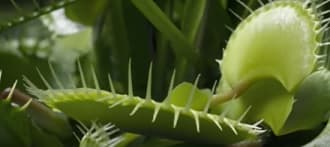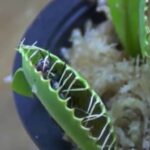As an Amazon Associate, this site earns commissions from qualifying purchases. For more details, click here.
Their exotic, alien-like appearance have made Venus flytraps one of the most popular carnivorous plants today. Yet they have also developed a reputation for being hard to grow. Based on my own experience, these plants are not difficult to cultivate, but do require a specific approach.
Venus flytraps grow in poor, moist soil and need at least 6 hours of direct sunlight. The ideal temperature range is 70-90 F (21-35 C) and humidity over 50%. Outdoor Venus flytraps attract insects so they don’t need to be fed. If the plant is indoors, feed every two weeks.
Best Location for Venus Flytraps
Venus flytraps are best grown outdoors during summer and indoor come winter season. Unless you live in zones, 8, 9 and 10, Venus flytraps will not live through below freezing winter outdoors.
You can place Venus flytraps in an open terrarium as long as it gets enough light and water. In spite of what you may have heard, Venus flytraps are not voracious eaters. While food is important, far more crucial for its growth are the soil, water, temperature and light.
I would not recommend closed terrariums for Venus flytraps. The plant won’t have access to insects and will require manual feeding. You also have to manage its light, humidity and temperature constantly.
Soil and Water
Venus flytraps grow in poor, acidic soil. Use 2/3 peat or sphagnum moss with 1/3 perlite or silica sand. You can add a bit of orchard bark though it is optional.
Never use regular potting soil. Carnivorous plants like Venus flytraps will not survive in rich soil, so avoid fertilizer as well.
Some people prefer peat moss and others sphagnum. Sphagnum tends to be looser than peat but it’s possible to pack the soil. I have tried both and they work fine for Venus flytraps. My personal choice is Perfect Plants Soil Mix as it is well suited for flytraps.
Good drainage is essential and the soil must always be moist. The easiest way to do this is with the tray method. Place your potted Venus flytrap on a saucer or tray. Pour an inch of water in the tray.
if you are using the tray method, there’s no need to spray the leaves with water. If it is really hot in your area and the tray dries quickly, a bit of spraying is fine.
Use only distilled or rainwater. I avoid tap water because it contains impurities and minerals that are harmful to plants.
Light
All Venus flytraps require a minimum of 6 hours of direct sunlight. You can tell the plant gets sufficient light because the trap interiors are a vivid reddish pink and has robust leaves. If your Venus flytrap is pale, not eating and not producing new traps, it likely needs more light.
Direct sunlight is the best, which is why most of these plants are outdoors during summer. Anywhere outdoors is fine as long as the plant receives plenty of light. You can also place the plant on a windowsill if it’s exposed to light.
If you are going to use artificial lights, I recommend Romsto Grow Lights because it serves as a good alternative to the sun and has no side effects on the plant.
Place indoor grow lights 7-8 inches away from Venus flytraps. Observe how the plant reacts to the light and make adjustments if necessary.
Related. How to Grow Venus flytraps Indoors
Humidity and Temperature
Venus flytraps grow best in 70-90 F (21-35 C), though some variants can tolerate lower or higher temperature.
This range is the most ideal, but these plants can handle a few degrees outside this. If it reaches the mid 90s, make sure the tray has sufficient water. if the temperature drops to 50 F (10 C) it will go dormant.
Venus flytraps do not need high humidity, but above 50% is optimal. If it is too low, here are some suggestions.
Buy a small humidifier. The Levoit Humidifier is perfect for Venus flytraps and other plants. You can set the humidity exactly where it needs to be. If your Venus flytraps and other plants are being seriously affected by the humidity, a humidifier is the best solution.
The tray method. Place your potted Venus flytrap on a tray. Add some pebbles around the tray and pour an inch of water on the tray. As the water evaporates, it will increase the humidity.
Feeding
There’s a lot of misconception about Venus flytraps and their food. I’m going to clear things up here.
You do not have to feed outdoor Venus flytraps. These plants feed on spiders, ants, flies and other insects, and these are aplenty outside. This video shows Venus flytraps in action.
The only exception is if your outdoor Venus flytrap is unable to catch prey. Flytraps eat every two weeks and take the same amount of time to digest its prey, so one of its traps should always be closed.
If your Venus flytrap isn’t eating, then it’s okay to feed it. Indoor and outdoor flytraps are fed the same way.
Put food in one of the traps. You only have to feed one trap at a time. Make sure the food is only 1/3 the size of the trap. If there is too much the trap won’t be able to close.
You can feed living or dead bugs, the plant cannot tell the difference. If it’s dead, use tweezers or a similar tool to stimulate the trap until it begins to close.
Do not feed burgers, steak, beef, hotdogs, candy, or other processed food to Venus flytraps. Don’t feed it fruits or vegetables either.
Pests and Diseases
There are four threats to Venus flytraps: fungus gnats, spider mites, aphids and playing with its traps.
Do not play around with the traps. You should only touch the traps with a paintbrush when feeding it.
Venus flytraps spend a lot of energy when closing traps. Forcing it to open and close weakens the trap and the plant itself.
Aphids. If your Venus flytrap has been infested, immerse it in rainwater or distilled water for a couple of days. Repeat this after one week.
If that doesn’t work, use neem oil or insecticidal soap. I prefer Mighty Mint as it is very effective.
Spider mites. Neem oil and insecticidal soaps are also efficient. If there is a only small number, spray them with water. But if your Venus flytrap has been infested, immerse it in water or use neem oil / insecticidal soap.
Fugus gnats. Keep the soil moist but not drenched. fungus gnats like very damp soil, so do not overwater the plant.
Venus flytraps leaves can turn black due to disease or dormancy. If winter is approaching and the leaves and traps turn black or brown, it is nothing to worry about. If this happens during summer, there might be infestation.

Dormancy
Venus flytraps go dormant when the temperature drops below 50 F (10 C). The plant stays dormant for 3-4 months and can handle temperature down to 20 F (-7 C).
When a Venus flytrap goes dormant, it sheds leaves, stops eating and loses luster. It will look like it is dying and people have mistaken it for the death of the plant.
But the plant isn’t dead. so don’t throw it away. Venus flytraps require dormancy in winter, otherwise it will not survive the next spring. As spring comes, the plant will slowly grow back its leaves and traps.
Dormant Venus flytraps still need light, so use artificial fixtures if possible. Leave a bit of water sitting in its tray so the soil remains a bit moist. As the plant comes to life again in spring, slowly increase the water and light exposure.
Dormant Venus flytraps can survive down to 20 F (-7 C). If it drops lower you have to put a cover on the plant or move it indoors. If the temperature will be below freezing for a week or more, mulch the pot.
The simplest solution for me is to just move the plant indoors. This way you don’t have to worry if the temperature is below freezing.
When to Repot
Repot Venus flytraps on an annual basis or if it has outgrown the pot. The pot should be at least 4 inches deep and 5 inches wide. Use 2/3 pear or sphagnum moss and 1/3 silica sand or perlite.
Small Venus flytraps can grow in a 3 inch deep pot, but I prefer 4 inches or even 5. The deeper the pot, the better for the roots. Venus flytrap roots need room to grow, so a spacious pot is good for it.
Even with a deep pot, Venus flytraps should still be repotted annually. It is good practice to replace the medium with something fresh to keep the plant healthy.
The pot should also be at least 5 inches wide. The wider the pot,, the more space roots can grow. A deep pot is nice, but a deep, wide one is even better. What you want to do is provide plenty of room for these roots to flourish.
When repotting, never use regular potting soil or fertilizer. Doing so is fatal for these plants. As long as you stick with 2/3 peat or sphagnum with 1/3 perlite/silica sand, you’ll be fine.
Propagation
There are three ways to propagate Venus flytraps: division, leaf cutting and seeds. I am going to focus on leaf cutting and division as seed propagation is hard.
Leaf cutting. Best time to do this is summer. Pull out a leaf from your Venus flytrap. Make sure there is a some rhizome on the leaf. Pull more leaves if you want, but there needs to be some left on the plant.
Put the leaf cutting in a pot with good drainage and the appropriate soil. Place the pot in a container to keep it moist.
Don’t worry if the leaf turns black, just trim it off. In six months or so you will see a small Venus flytrap appear. If multiple plants grow, put them in separate pots.
Division. Wait for later winter or spring to do this. Carefully remove the plant from its pot.
Cut the plant into two or more parts (your choice), but each one must have part of the roots. Place the newly divided plants in a pot with soil (sphagnum or peat with silica or perlite). Care for the plant using the methods given here.

My fascination with carnivorous plants began many, many years ago with Venus Fly Traps. Now I am more than happy to impart what I know with other enthusiasts and those who are curious about meat eating plants.


